Karaage Chicken is one of the most popular Japanese dishes not only within Japan but abroad as well. The chicken is marinated with soy sauce, sake, ginger, and mirin to give a touch of sweetness.
I originally posted this recipe in September 2016 and updated in 2018 with a recipe video. Now I’ve improved the video as well as the contents.
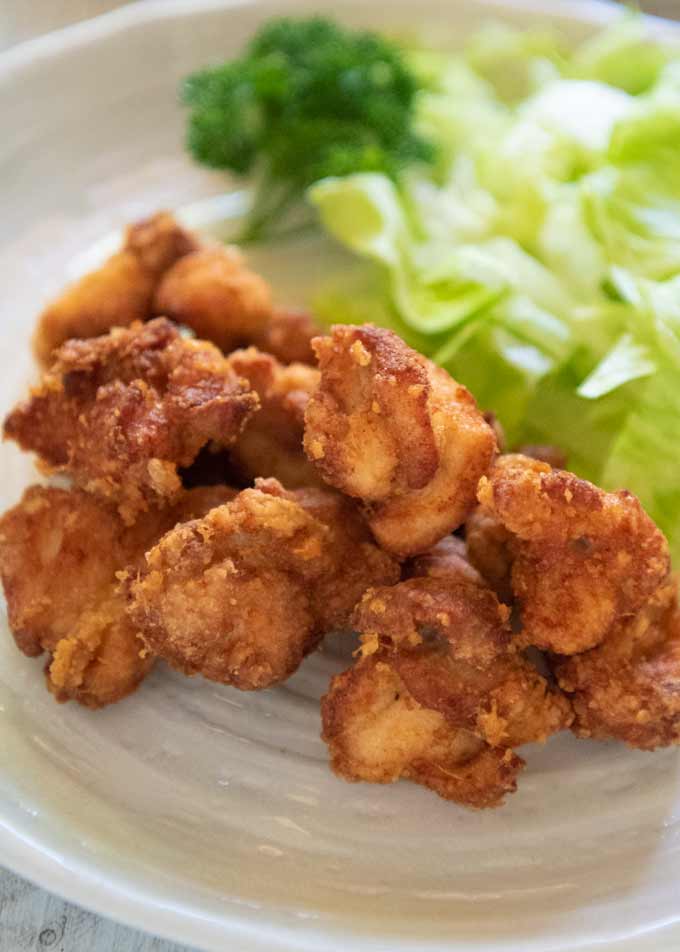
This is a little-known secret outside of Japan, but the chicken pieces are deep fried twice to make them crunchy on the outside and juicy inside!
Karaage Chicken is my children’s long standing no. 1 favourite dish within my repertoire. Whenever I declare that I will cook a Japanese meal for them, Karaage Chicken comes up first.
About Karaage
Some people might be thinking that karaage is Japanese-style fried chicken. But this is not correct. The word ‘karaage‘ (唐揚げ) is a generic term for deep fried food coated with or without flour. You don’t have to use chicken.
So Karaage chicken is ‘tori no karaage‘ (鶏の唐揚げ, fried chicken) in Japanese, qualifying that it is chicken (tori, 鶏).
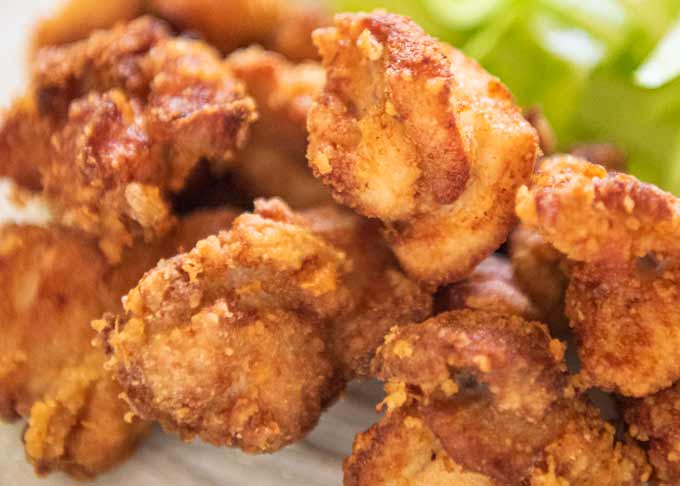
Karaage originally meant deep fried meat or fish without any marinating. The cooking method of pre-marinating ingredients came from China in the early Edo period. At the time, Japanese people called China ‘tou’ (唐), but this kanji character can also read ‘kara‘, particularly when combined with other characters. Hence the word 唐揚げ became ‘karaage’ instead of ‘touage‘.
If you marinate the meat/fish with some flavourings such as soy sauce before coating with cornflour, the dish becomes ‘tatsuta age’ (竜田揚げ). You can see the tatsuta age recipe using mackerel here.
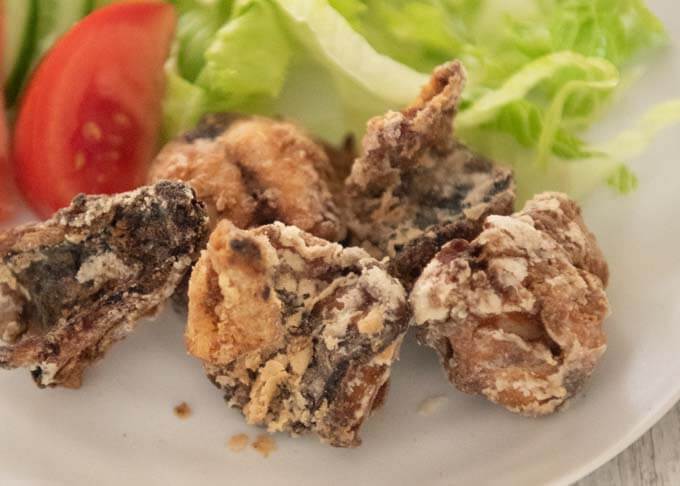
Mackerel Tatsuta Age
As explained in the post Mackerel Tatsuta Age, only if the fish/meat is flavoured and coated with corn flour before deep-frying, it is called Tatsuta Age.
On the other hand, the definition of Karaage is rather vague. You can deep fry fish/meat with or without flavouring, and you don’t have to coat the ingredient with flour. The flour can be any kind of flour.
People often call Japanese-style fried chicken Karaage because chicken is the most popular Karaage ingredient.
What’s in My Japanese Fried chicken (Karaage Chicken)
There aren’t many ingredients involved in making Karaage Chicken. The marinade is made up of typical Japanese pantry items.
- Chicken thigh fillets cut into large bite-size pieces
- Corn flour/cornstarch
- Vegetable oil for deep-frying
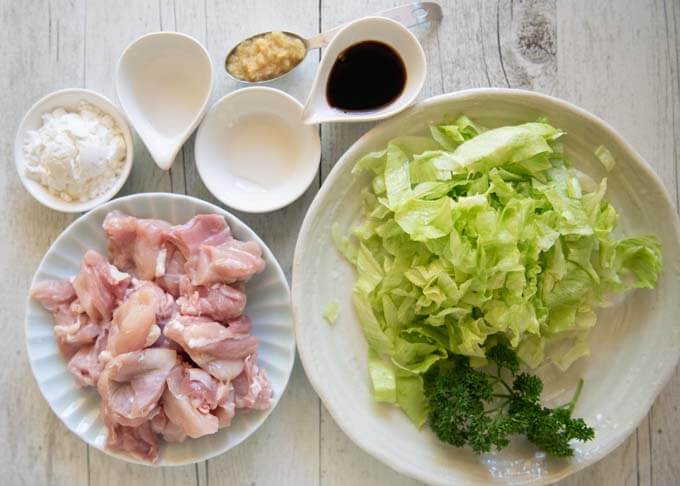
I sometimes use thigh fillets with skin on, but sometimes I use skinless fillets (as seen in the video). Instead of thigh fillets, you can use breast fillets, but the cooked chicken will be a little bit dry.
I used corn flour/cornstarch to coat the chicken pieces this time, but I often use plain flour instead. You could also use equal parts corn flour and plain flour. I find that corn flour makes the coating lighter when deep fried.
Marinade
- Soy sauce
- Cooking sake
- Mirin
- Freshly grated ginger, including juice
There are so many variations to the marinade. Some recipes don’t add mirin. The younger generations appear to like the marinade with garlic added, making the flavour closer to the Chinese version. I like it without garlic to keep the authentic Japanese flavour. And that’s the Karaage Chicken flavour that I remember.
How to Make Japanese Fried chicken (Karaage Chicken)
My karaage chicken is marinated before frying.
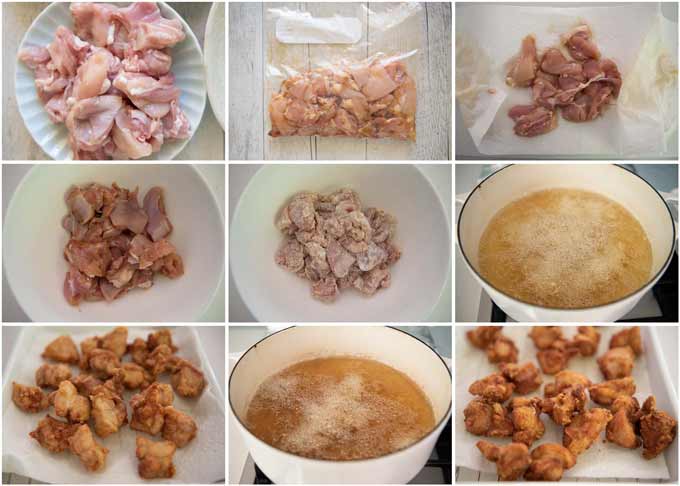
- Cut the fillets into large bite size pieces – about 5cm x 4cm / 2″ x 1½”.
- Put the chicken pieces and the Marinade ingredients in a ziplock bag, and massage well to coat every piece of meat with the marinade.
- Marinate for 30 minutes to 1 hour.
- Pat-dry the chicken pieces.
- Coat the chicken pieces with corn flour/cornstarch.
- Deep-fry the chicken pieces at 160°C/320°F.
- Rest the fried chicken for 3-4 minutes, then deep-fry at 190-200°C/374-392°F.
The temperature of the oil is critical. If the temperature of the oil in step 6 is too high, your chicken pieces become dark brown while inside of the chicken is still raw. If the temperature of the oil in step 7 is too low, you will end up with oily Karaage Chicken.
If you have a kitchen thermometer, that will be great. If you don’t, dip a pair of bamboo chopsticks in the oil and check the approximate temperature. If tiny bubbles are quietly forming around the chopsticks, then it is about 160-165°C/320-329°F, if larger bubbles are quickly rising, it is 180-190°C/356-374°F. You might find it difficult to see the difference in the comparison photo below, but hopefully you can see larger bubbles are coming up in the right photo.
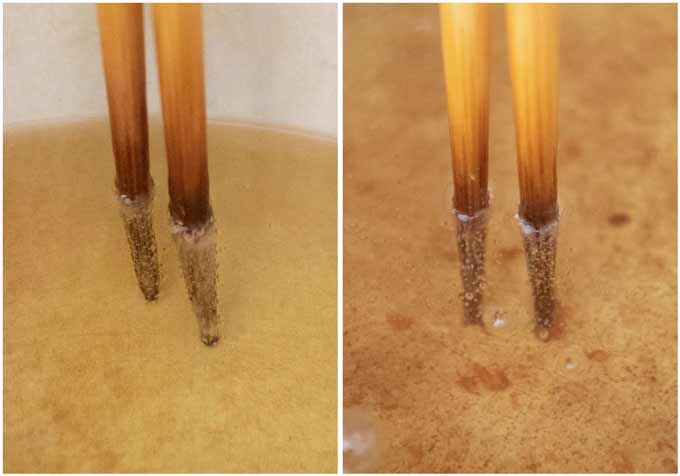
Oil temperature at around 160-165°C/320-329°F (left) and 180-190°C/356-374°F (right).
Secret to Crispy Karaage Chicken
The secret to great Karaage Chicken with crunchy outside and juicy inside is the double-frying.
- Cook the chicken pieces by deep frying them at a lower temperature (about 160-165°C/320-329°F). The objective of this step is to cook the chicken to just before fully cooked without browning the surface too much.
- Rest for 3-4 minutes during which the residual heat cooks the chicken through.
- Deep fry the chicken pieces for the second time at about 190-200°C/374-392°F to make the outside of the chicken crunchy. This step is necessary because the first frying will make soggy fried chicken due to the lower temperature.
Frying twice as above ensures that the outside of the Karaage Chicken is crunchy and golden brown while the inside is juicy.
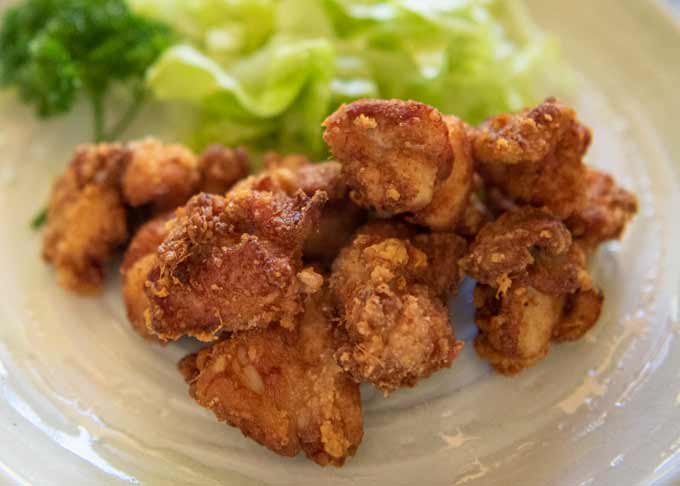
Yes, you need to do deep-frying (some people don’t seem to like it), but it is worth the effort.
Yumiko![]()
WATCH HOW TO MAKE IT
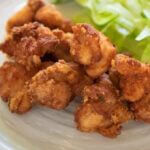
Recipe Video Above. One of the most popular Japanese dishes, not only within Japan but abroad, Karaage Chicken is pretty easy to make as long as you don't mind deep frying. Just marinate the chicken, toss in flour, and deep fry. Simple as that. The key is double frying so that the chicken becomes crunchy outside and juicy inside.
Don't forget to see the section 'MEAL IDEAS' below the recipe card! It gives you a list of dishes that I have already posted and this recipe that can make up a complete meal. I hope it is of help to you.
- 350g/12.3oz chicken thigh fillets , cut into large bite size pieces (Note 1)
- 20g/0.7oz corn flour / cornstarch
- Vegetable oil for deep frying
- 1 tbsp soy sauce
- 1 tbsp cooking sake
- 1/2 tsp mirin (Note 2)
- 2 tsp freshly grated ginger including juice
- Shredded lettuce or cabbage
- Sprigs of parsley
-
Pat chicken pieces dry with paper towel. Put the chicken and the Marinade ingredients into a ziplock bag or a bowl.
-
Massage the bag well ensuring that all pieces are coated with the marinade. Marinate for 30 minutes to an hour.
-
Heat enough oil in a deep pot or pan to 160°C/320°F (note 3). The depth of the oil should be about 3-4cm/1¼-1½”.
-
Meanwhile, drain excess marinade from the chicken, place the chicken pieces on paper towels to remove excess liquid, and put them in a bowl.
-
Sprinkle over the corn flour and turn chicken to coat every piece with corn flour.
-
Fry chicken in batches. Add several chicken pieces to the oil one by one and fry for about 2.5-3 minutes (note 4). You may want to move the chicken pieces around as they tend to stick to the bottom of the pot/pan.
-
Take the chicken pieces out of the oil and rest for at least 3-4 minutes (note 5) on paper towels. Repeat with remaining chicken pieces.
-
Skim any flour crumbs from the oil if there are any and increase the temperature of the oil to 190-200°C/374-392°F (note 3).
-
Put the chicken pieces back into the oil in batches and fry for about 30 seconds to 1 minute until golden brown and crunchy. Repeat with remaining chicken pieces.
-
Serve immediately with shredded lettuce and parsley for decoration if using.
1. I cut the chicken thigh into about 5 x 4cm/2 x 1.6". You can make it smaller or slightly larger. Then cooking time would need to be adjusted.
2. Sugar can be substituted for mirin. The sweetness of sugar vs mirin is 2:1 so use 1/4 teaspoon of sugar. Make sure you mix the marinade well to dissolve.
3. I don't normally use a thermometer to check the temperature of the oil. I dip a pair of bamboo chopsticks in the oil and check the approximate temperature. If tiny bubbles are quietly forming around the chopsticks, then it is about 160-165°C/320-329°F, if larger bubbles are quickly rising, it is 180-190°C/356-374°F.
4. To maintain the temperature of the oil, do not overcrowd the oil with too many chicken pieces. I used a 20cm/8" pot and deep fried in 2 batches with no more than 5-6 chicken pieces at once.
5. While resting, the chicken continues to cook slowly resulting in tender juicy chicken.
6. If you are making a large amount of Karaage Chicken, hold the fried chicken in the oven. Before frying the chicken, turn the oven on to around 80-100°C (176-212°F). As you finish frying the chicken pieces for the second time, keep them on the tray in the oven while you fry the others.
7. Nutrition information assumes that the vegetable oil absorbed into the fried chicken is about 8% of the weight of the chicken. Garnish is not included.
serving: 217g calories: 523kcal fat: 40g (62%) saturated fat: 7.9g (40%) trans fat: 0.3g polyunsaturated fat: 8.1g monounsaturated fat: 21g cholesterol: 166mg (55%) sodium: 705mg (29%) potassium: 411mg (12%) carbohydrates: 9.4g (3%) dietary fibre: 0.8g (3%) sugar: 0.7g protein: 30g vitamin a: 3% vitamin c: 0.2% calcium: 1.8% iron: 7.6%
Originally published in September 2016, updated in September 2018 to include a recipe video and Meal Ideas, improved contents with new photos and video in February 2022.
Meal Ideas
A typical Japanese meal consists of a main dish, a couple of side dishes, a soup and rice. I try to come up with a combination of dishes with a variety of flavours, colours, textures and make-ahead dishes.
You should try to match the oily main dish with some vegetables that can assist digestion. The daikon (white radish) in the salad is perfect for this. Hijiki Seaweed Salad adds a different flavour to the meal.
- Main: Japanese Fried Chicken (Karaage Chicken) – today’s recipe.
- Side dish 1: Persimmon Daikon Salad – if persimmon is not in season, try Daikon Salad with Pickled Plum Dressing.
- Side dish 2: Hijiki Seaweed Salad – make ahead, alternative can be Scrambled Tofu (Iri Tofu) if you cannot buy hijiki seaweed.
- Soup: Miso Soup of your choice from Miso Soup Ingredient Combinations – I would go with potato, wakame seaweed and shallots/scallions.
- Rice: Cooked Rice.
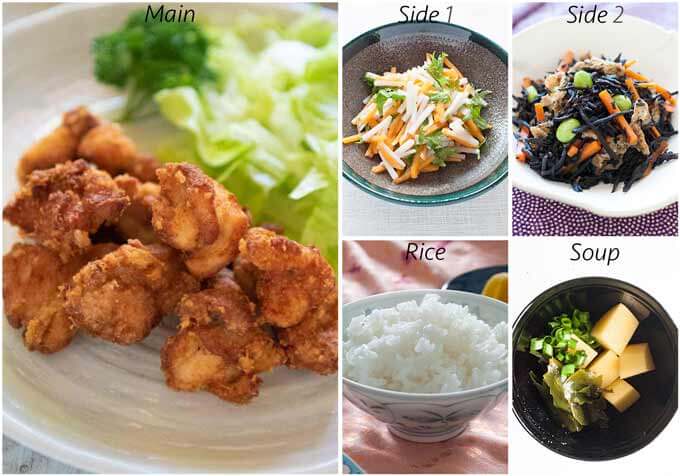
Can I make this slightly ahead of time ( 2 hours ahead) and take to the Hollywood Bowl for a nice dinner?
Hi Betsie, of course you can. If the karaage chicken are still hot or even warm, do not cover them completely and allow for the steam to escape. Otherwise the crust gets soggy and the chicken loses crunchiness.
Hi Yumiko,
Your Chicken Karaage was such a hit at a recent pot-luck lunch we hosted. It was loved by all and there was nothing left! There was so much praise and I couldn’t keep your recipe a secret to myself haha.
I loved that it was so easy to make for such delicious taste and texture. I can’t wait to make it again.
Hi Tina, thanks for a positive feedback. I’m glad that you got great feedbacks on Karaage Chicken!.
Hi Yumiko, how many pieces of karaage can one make with 1 kg of chichen thigh?
Base on the 30 gm cuts.
What happens if the cuts is smaller, does it change the taste or quality of karaage chicken?
Hi Matthias, you can simply divide 1000g by 30g. So, you will 30+. If each piece is only slightly smaller, the flavour would not be different, but if the chicken pieces are very small, marinate them for a shorter duration. Karaage chicken made with a very small piece might be a bit drier.
If I can not find cooking sake, what else could I use?
Hi Amy, if you can buy drinking sake, you can use it, although drinking sake is much more expensive. Alternatively, you can use dry sherry or Chinese rice wine.
Hi , you can get cooking sake at Coles , the brand is Obenti , in the Asian section
Can you fry the chicken several days before, then use an air fryer to reheat it on the day you’re going to have it?
Will it turn out just as good?
Hi Adele, I don’t have air fryer, so I don’t know what it will do. But, I am guessing that it might become a bit dry.
I’ve bought karaage and reheated it in an air fryer days later and it was still pretty great, so I wouldn’t worry about it. It’s never as good as fresh, but it’ll still be very tasty.
This was absolutely amazing! The ginger definitely makes a difference. My 10yr old son told me to make the chicken every day for him. It was so crispy on the outside yet moist on the inside (on a side note I used chicken thighs. I think breasts would be to dry).
Thank you for a simple yet delicious recipe 🙂
Hi Lee, wonderful! I agree that chicken thigh is juicier when cooked.
I put thick teriyaki sauce and cupi Mayo over this and omg it us my favourite meal!!
Hi Craig, wow!
The fresh ginger in the marinade makes this next level. So crunchy so delicious!
Hi Tracey, that’s great! The ginger does make a difference, doesn’t it?
Can you use white flour instead of corn flour.?
Hi Euni, yes you can. Some recipes use normal flour.
Dear Umiko,
Corn starch is the same as Maizena? Sorry for the dumb question.
And thank you.
Hi Cecilia, yes it is. Maizena is a brand of corn flour (also called cornstarch in other countries).
Corn or potato starch will give you the best results.